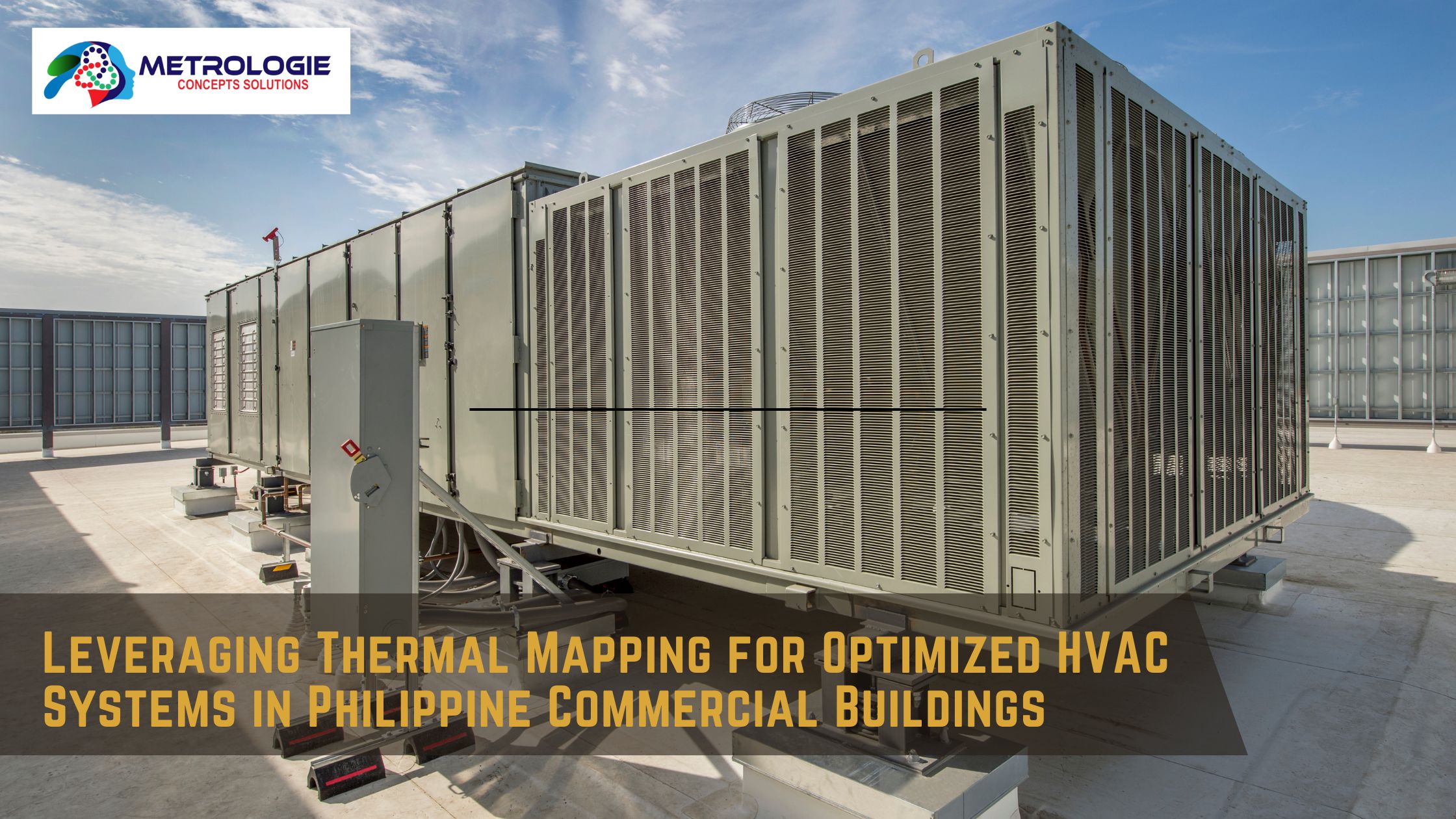In the ever-evolving landscape of commercial real estate, optimizing HVAC (Heating, Ventilation, and Air Conditioning) systems is critical for maintaining energy efficiency, ensuring occupant comfort, and managing operational costs. In the Philippines, where the climate poses unique challenges, leveraging thermal mapping can significantly enhance the performance and efficiency of HVAC systems in commercial buildings. This article delves into how thermal mapping can be a game-changer for optimizing HVAC systems, the benefits it brings, and practical steps for implementation.
1. Introduction: The Role of HVAC Systems in Commercial Buildings
HVAC systems are vital components in commercial buildings, ensuring that indoor environments remain comfortable and conducive to productivity. These systems regulate temperature, humidity, and air quality, directly impacting the well-being of occupants and the operational efficiency of the building.
In the Philippines, where temperatures and humidity levels can be extreme, effective HVAC management becomes even more critical. Commercial buildings, from office spaces and shopping malls to hotels and hospitals, require robust HVAC systems to handle the unique challenges posed by the tropical climate.
However, maintaining and optimizing HVAC systems can be complex and costly. This is where thermal mapping comes into play, offering a powerful tool for improving HVAC system performance and efficiency.
2. Understanding Thermal Mapping
What is Thermal Mapping?
Thermal mapping is a process that uses thermal imaging technology to visualize temperature variations across a surface or environment. By capturing thermal images, it provides a detailed view of temperature distribution, which can be analyzed to identify heat-related issues and inefficiencies.
How Thermal Mapping Works
Thermal mapping involves using infrared cameras or sensors to capture thermal radiation emitted by objects and surfaces. These devices translate infrared radiation into visible thermal images, which display temperature variations as color-coded patterns. By analyzing these images, technicians can pinpoint areas of heat loss, hotspots, and other temperature-related anomalies.
3. The Importance of Thermal Mapping in HVAC Optimization
Identifying Energy Inefficiencies
One of the primary benefits of thermal mapping is its ability to identify energy inefficiencies within an HVAC system. By visualizing temperature variations, technicians can detect areas where heat is being lost or where cooling is insufficient. This information is crucial for pinpointing problems such as inadequate insulation, air leaks, or malfunctioning components that can lead to increased energy consumption.
Detecting HVAC System Failures
Thermal mapping can also help in detecting HVAC system failures before they become critical. Temperature anomalies in thermal images can indicate issues such as clogged filters, failing compressors, or malfunctioning fans. Early detection of these problems allows for timely repairs, reducing the risk of system breakdowns and ensuring continuous operation.
Enhancing Occupant Comfort
Maintaining a comfortable indoor environment is essential for occupant satisfaction and productivity. Thermal mapping helps ensure that HVAC systems provide consistent and even temperature distribution throughout a building. By identifying areas with temperature imbalances or drafts, building managers can make adjustments to improve comfort and avoid complaints from occupants.
4. Thermal Mapping Technologies and Tools
Infrared Thermography
Infrared thermography is the primary technology used in thermal mapping. It involves capturing thermal images using infrared cameras, which detect and record temperature variations. Modern infrared cameras offer high-resolution imaging and advanced features such as real-time temperature monitoring and data recording.
Thermal Cameras and Sensors
Thermal cameras are designed to capture infrared radiation and produce thermal images. They come in various models and specifications, including handheld devices and stationary units. Sensors can also be integrated into HVAC systems to provide continuous temperature monitoring and data collection.
Data Analysis Software
Data analysis software is used to interpret thermal images and generate detailed reports. This software helps in identifying patterns, trends, and anomalies in temperature data. It can also be used to compare thermal images over time, track changes, and assess the effectiveness of HVAC optimizations.
5. Benefits of Thermal Mapping for HVAC Systems
Energy Savings
One of the most significant benefits of thermal mapping is the potential for energy savings. By identifying and addressing energy inefficiencies, building managers can reduce energy consumption and lower utility bills. For example, fixing air leaks or improving insulation can lead to substantial reductions in heating and cooling costs.
Reduced Operational Costs
Thermal mapping helps in reducing operational costs by preventing HVAC system failures and minimizing maintenance expenses. Early detection of issues allows for prompt repairs, preventing costly breakdowns and extending the lifespan of HVAC equipment. Additionally, optimized systems operate more efficiently, reducing overall maintenance requirements.
Improved Equipment Longevity
Regular thermal mapping and maintenance contribute to the longevity of HVAC equipment. By addressing issues such as overheating or component wear, building managers can prevent premature equipment failure. This proactive approach extends the lifespan of HVAC systems and reduces the need for frequent replacements.
Enhanced Building Performance
Optimized HVAC systems contribute to better building performance by maintaining consistent indoor temperatures and air quality. This leads to improved occupant comfort and satisfaction, which can have positive effects on productivity and overall building utilization.
6. Implementing Thermal Mapping in Philippine Commercial Buildings
Assessing Your Current HVAC System
Before implementing thermal mapping, it is essential to assess the current state of your HVAC system. This involves evaluating system performance, identifying existing issues, and determining areas where thermal mapping can provide the most benefit.
Choosing the Right Thermal Mapping Tools
Selecting the appropriate thermal mapping tools is crucial for accurate and effective analysis. Consider factors such as camera resolution, temperature range, and data analysis capabilities when choosing infrared cameras and sensors. It may also be beneficial to consult with experts to ensure you have the right equipment for your specific needs.
Conducting a Thermal Mapping Survey
A thermal mapping survey involves capturing thermal images of your HVAC system and building environment. This process typically includes scanning areas such as ducts, vents, insulation, and equipment components. The survey results provide valuable insights into temperature distribution and potential issues.
Analyzing and Interpreting Data
Once thermal images are captured, they need to be analyzed and interpreted to identify temperature anomalies and inefficiencies. Use data analysis software to generate reports and visualize trends. Look for patterns that indicate energy loss, equipment malfunctions, or areas of discomfort.
Making Informed Decisions for HVAC Optimization
Based on the thermal mapping data, make informed decisions to optimize your HVAC system. This may involve adjusting system settings, repairing or replacing components, improving insulation, or addressing airflow issues. Implementing these changes can enhance system performance and energy efficiency.
7. Challenges and Considerations
Climate-Specific Challenges in the Philippines
The tropical climate of the Philippines presents unique challenges for HVAC systems, including high temperatures and humidity levels. Thermal mapping can help address these challenges by identifying specific issues related to heat gain, moisture control, and system performance.
Common Misconceptions about Thermal Mapping
Some common misconceptions about thermal mapping include the belief that it is a costly or complex process. In reality, thermal mapping is a valuable tool that can provide significant returns on investment through energy savings and improved system performance.
Addressing Privacy and Safety Concerns
When conducting thermal mapping, it is essential to address privacy and safety concerns. Ensure that thermal images are used responsibly and that any sensitive information is protected. Work with professionals who follow best practices for data handling and confidentiality.
8. Future Trends in Thermal Mapping and HVAC Optimization
Advances in Thermal Imaging Technology
Thermal imaging technology continues to evolve, with advancements in camera resolution, data analysis capabilities, and real-time monitoring. Staying updated with the latest technology can enhance the effectiveness of thermal mapping and HVAC optimization efforts.
Integration with Smart Building Systems
Thermal mapping can be integrated with smart building systems to provide continuous monitoring and automated adjustments. This integration allows for real-time temperature control, predictive maintenance, and enhanced system performance.
Predictive Maintenance and IoT
The Internet of Things (IoT) and predictive maintenance are emerging trends that complement thermal mapping. By combining thermal data with IoT sensors and predictive analytics, building managers can proactively address issues before they impact system performance.
9. Conclusion: Embracing Thermal Mapping for a Sustainable Future
Thermal mapping is a powerful tool for optimizing HVAC systems in Philippine commercial buildings. By leveraging thermal imaging technology, building managers can identify energy inefficiencies, detect system failures, and enhance occupant comfort. The benefits of thermal mapping include energy savings, reduced operational costs, improved equipment longevity, and enhanced building performance.
As the commercial real estate sector continues to grow and evolve, embracing thermal mapping can lead to more sustainable and efficient HVAC systems. By staying informed about the latest technologies and trends, building managers can ensure their HVAC systems remain effective and reliable for years to come.




